Chuanbo Hu
URSimulator: Human-Perception-Driven Prompt Tuning for Enhanced Virtual Urban Renewal via Diffusion Models
Sep 22, 2024Abstract:Tackling Urban Physical Disorder (e.g., abandoned buildings, litter, messy vegetation, graffiti) is essential, as it negatively impacts the safety, well-being, and psychological state of communities. Urban Renewal is the process of revitalizing these neglected and decayed areas within a city to improve the physical environment and quality of life for residents. Effective urban renewal efforts can transform these environments, enhancing their appeal and livability. However, current research lacks simulation tools that can quantitatively assess and visualize the impacts of renewal efforts, often relying on subjective judgments. Such tools are crucial for planning and implementing effective strategies by providing a clear visualization of potential changes and their impacts. This paper presents a novel framework addressing this gap by using human perception feedback to simulate street environment enhancement. We develop a prompt tuning approach that integrates text-driven Stable Diffusion with human perception feedback, iteratively editing local areas of street view images to better align with perceptions of beauty, liveliness, and safety. Our experiments show that this framework significantly improves perceptions of urban environments, with increases of 17.60% in safety, 31.15% in beauty, and 28.82% in liveliness. In contrast, advanced methods like DiffEdit achieve only 2.31%, 11.87%, and 15.84% improvements, respectively. We applied this framework across various virtual scenarios, including neighborhood improvement, building redevelopment, green space expansion, and community garden creation. The results demonstrate its effectiveness in simulating urban renewal, offering valuable insights for urban planning and policy-making.
Video-based Analysis Reveals Atypical Social Gaze in People with Autism Spectrum Disorder
Sep 01, 2024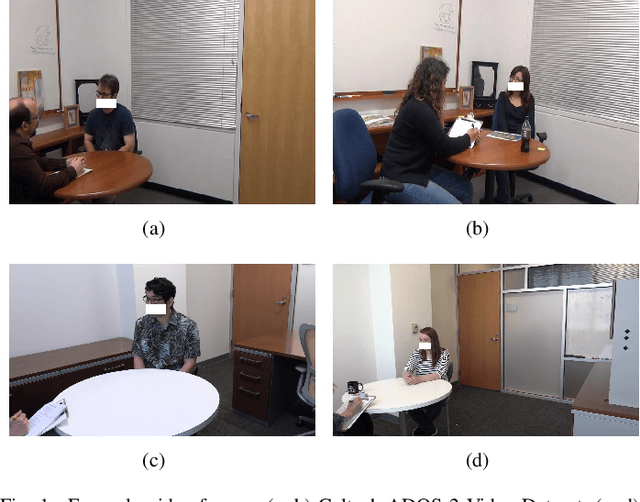
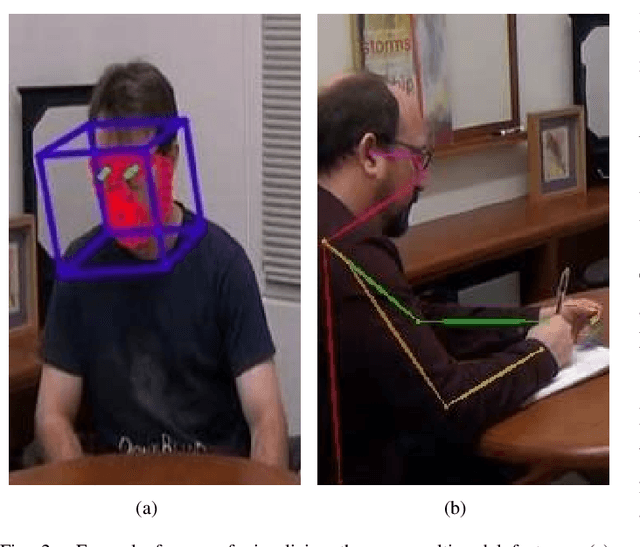
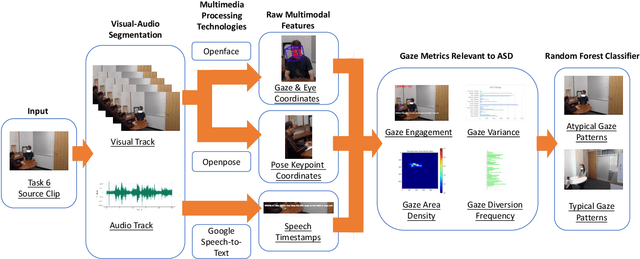

Abstract:In this study, we present a quantitative and comprehensive analysis of social gaze in people with autism spectrum disorder (ASD). Diverging from traditional first-person camera perspectives based on eye-tracking technologies, this study utilizes a third-person perspective database from the Autism Diagnostic Observation Schedule, 2nd Edition (ADOS-2) interview videos, encompassing ASD participants and neurotypical individuals as a reference group. Employing computational models, we extracted and processed gaze-related features from the videos of both participants and examiners. The experimental samples were divided into three groups based on the presence of social gaze abnormalities and ASD diagnosis. This study quantitatively analyzed four gaze features: gaze engagement, gaze variance, gaze density map, and gaze diversion frequency. Furthermore, we developed a classifier trained on these features to identify gaze abnormalities in ASD participants. Together, we demonstrated the effectiveness of analyzing social gaze in people with ASD in naturalistic settings, showcasing the potential of third-person video perspectives in enhancing ASD diagnosis through gaze analysis.
Multimodal Chain-of-Thought Reasoning via ChatGPT to Protect Children from Age-Inappropriate Apps
Jul 08, 2024



Abstract:Mobile applications (Apps) could expose children to inappropriate themes such as sexual content, violence, and drug use. Maturity rating offers a quick and effective method for potential users, particularly guardians, to assess the maturity levels of apps. Determining accurate maturity ratings for mobile apps is essential to protect children's health in today's saturated digital marketplace. Existing approaches to maturity rating are either inaccurate (e.g., self-reported rating by developers) or costly (e.g., manual examination). In the literature, there are few text-mining-based approaches to maturity rating. However, each app typically involves multiple modalities, namely app description in the text, and screenshots in the image. In this paper, we present a framework for determining app maturity levels that utilize multimodal large language models (MLLMs), specifically ChatGPT-4 Vision. Powered by Chain-of-Thought (CoT) reasoning, our framework systematically leverages ChatGPT-4 to process multimodal app data (i.e., textual descriptions and screenshots) and guide the MLLM model through a step-by-step reasoning pathway from initial content analysis to final maturity rating determination. As a result, through explicitly incorporating CoT reasoning, our framework enables ChatGPT to understand better and apply maturity policies to facilitate maturity rating. Experimental results indicate that the proposed method outperforms all baseline models and other fusion strategies.
Exploring Speech Pattern Disorders in Autism using Machine Learning
May 03, 2024
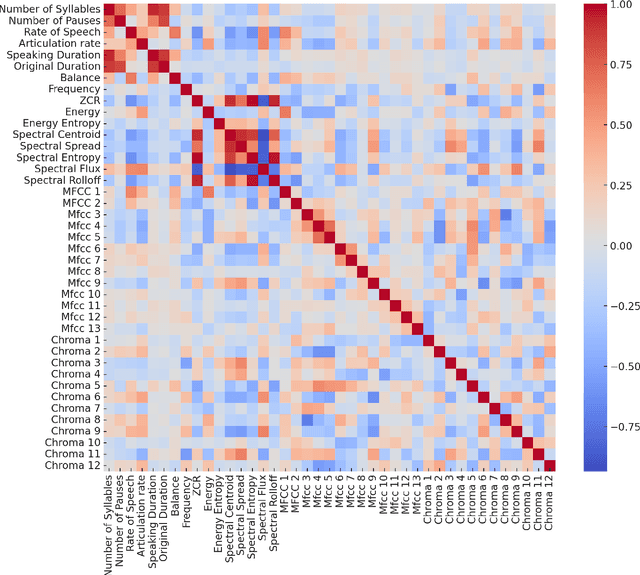
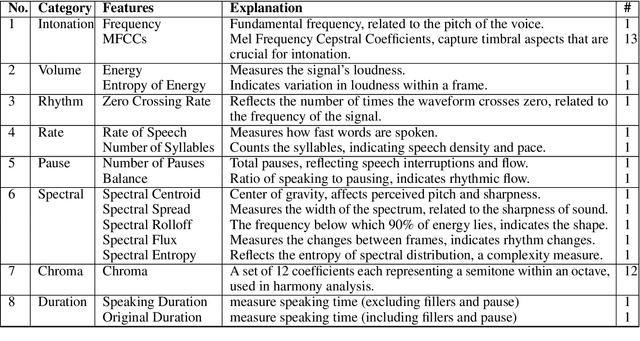
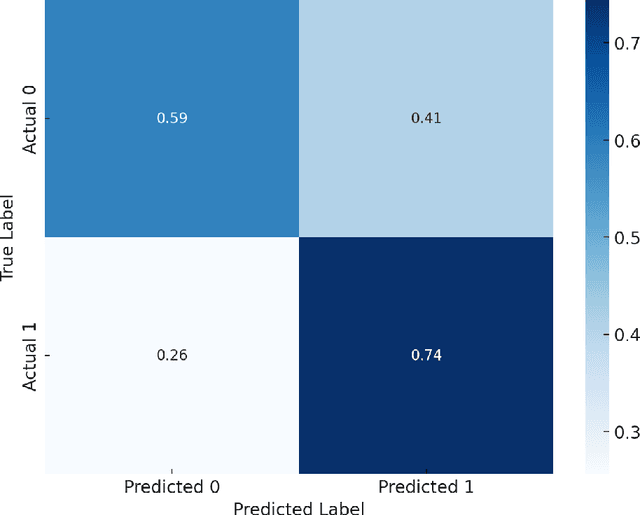
Abstract:Diagnosing autism spectrum disorder (ASD) by identifying abnormal speech patterns from examiner-patient dialogues presents significant challenges due to the subtle and diverse manifestations of speech-related symptoms in affected individuals. This study presents a comprehensive approach to identify distinctive speech patterns through the analysis of examiner-patient dialogues. Utilizing a dataset of recorded dialogues, we extracted 40 speech-related features, categorized into frequency, zero-crossing rate, energy, spectral characteristics, Mel Frequency Cepstral Coefficients (MFCCs), and balance. These features encompass various aspects of speech such as intonation, volume, rhythm, and speech rate, reflecting the complex nature of communicative behaviors in ASD. We employed machine learning for both classification and regression tasks to analyze these speech features. The classification model aimed to differentiate between ASD and non-ASD cases, achieving an accuracy of 87.75%. Regression models were developed to predict speech pattern related variables and a composite score from all variables, facilitating a deeper understanding of the speech dynamics associated with ASD. The effectiveness of machine learning in interpreting intricate speech patterns and the high classification accuracy underscore the potential of computational methods in supporting the diagnostic processes for ASD. This approach not only aids in early detection but also contributes to personalized treatment planning by providing insights into the speech and communication profiles of individuals with ASD.
Exploiting ChatGPT for Diagnosing Autism-Associated Language Disorders and Identifying Distinct Features
May 03, 2024
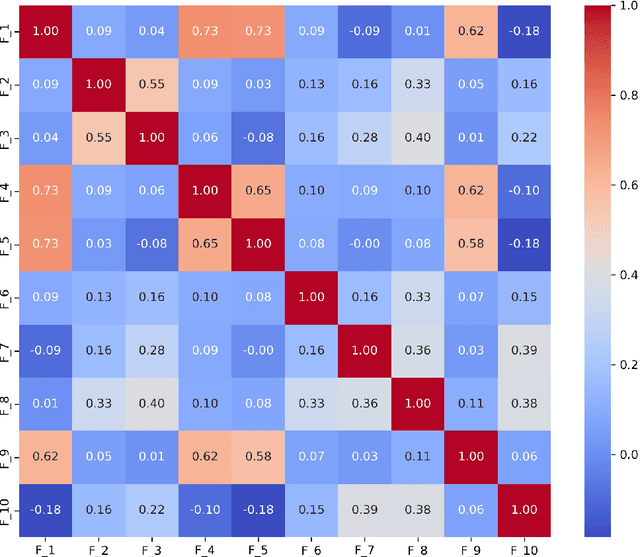

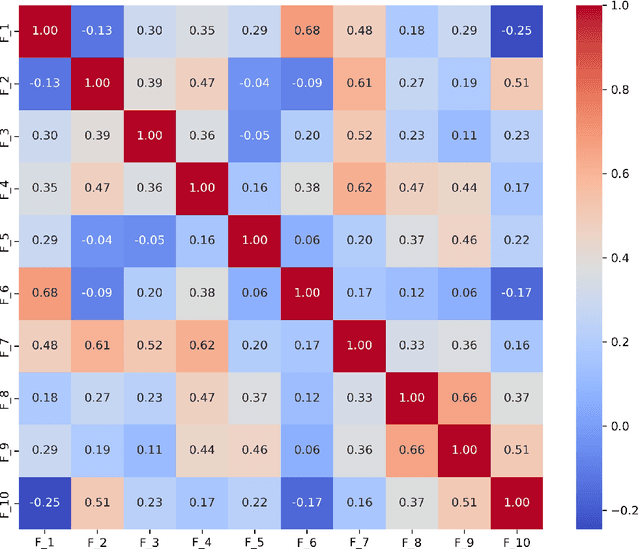
Abstract:Diagnosing language disorders associated with autism is a complex and nuanced challenge, often hindered by the subjective nature and variability of traditional assessment methods. Traditional diagnostic methods not only require intensive human effort but also often result in delayed interventions due to their lack of speed and specificity. In this study, we explored the application of ChatGPT, a state of the art large language model, to overcome these obstacles by enhancing diagnostic accuracy and profiling specific linguistic features indicative of autism. Leveraging ChatGPT advanced natural language processing capabilities, this research aims to streamline and refine the diagnostic process. Specifically, we compared ChatGPT's performance with that of conventional supervised learning models, including BERT, a model acclaimed for its effectiveness in various natural language processing tasks. We showed that ChatGPT substantially outperformed these models, achieving over 13% improvement in both accuracy and F1 score in a zero shot learning configuration. This marked enhancement highlights the model potential as a superior tool for neurological diagnostics. Additionally, we identified ten distinct features of autism associated language disorders that vary significantly across different experimental scenarios. These features, which included echolalia, pronoun reversal, and atypical language usage, were crucial for accurately diagnosing ASD and customizing treatment plans. Together, our findings advocate for adopting sophisticated AI tools like ChatGPT in clinical settings to assess and diagnose developmental disorders. Our approach not only promises greater diagnostic precision but also aligns with the goals of personalized medicine, potentially transforming the evaluation landscape for autism and similar neurological conditions.
Can ChatGPT Detect DeepFakes? A Study of Using Multimodal Large Language Models for Media Forensics
Mar 26, 2024



Abstract:DeepFakes, which refer to AI-generated media content, have become an increasing concern due to their use as a means for disinformation. Detecting DeepFakes is currently solved with programmed machine learning algorithms. In this work, we investigate the capabilities of multimodal large language models (LLMs) in DeepFake detection. We conducted qualitative and quantitative experiments to demonstrate multimodal LLMs and show that they can expose AI-generated images through careful experimental design and prompt engineering. This is interesting, considering that LLMs are not inherently tailored for media forensic tasks, and the process does not require programming. We discuss the limitations of multimodal LLMs for these tasks and suggest possible improvements.
Unveiling the Potential of Knowledge-Prompted ChatGPT for Enhancing Drug Trafficking Detection on Social Media
Jul 07, 2023



Abstract:Social media platforms such as Instagram and Twitter have emerged as critical channels for drug marketing and illegal sale. Detecting and labeling online illicit drug trafficking activities becomes important in addressing this issue. However, the effectiveness of conventional supervised learning methods in detecting drug trafficking heavily relies on having access to substantial amounts of labeled data, while data annotation is time-consuming and resource-intensive. Furthermore, these models often face challenges in accurately identifying trafficking activities when drug dealers use deceptive language and euphemisms to avoid detection. To overcome this limitation, we conduct the first systematic study on leveraging large language models (LLMs), such as ChatGPT, to detect illicit drug trafficking activities on social media. We propose an analytical framework to compose \emph{knowledge-informed prompts}, which serve as the interface that humans can interact with and use LLMs to perform the detection task. Additionally, we design a Monte Carlo dropout based prompt optimization method to further to improve performance and interpretability. Our experimental findings demonstrate that the proposed framework outperforms other baseline language models in terms of drug trafficking detection accuracy, showing a remarkable improvement of nearly 12\%. By integrating prior knowledge and the proposed prompts, ChatGPT can effectively identify and label drug trafficking activities on social networks, even in the presence of deceptive language and euphemisms used by drug dealers to evade detection. The implications of our research extend to social networks, emphasizing the importance of incorporating prior knowledge and scenario-based prompts into analytical tools to improve online security and public safety.
UPDExplainer: an Interpretable Transformer-based Framework for Urban Physical Disorder Detection Using Street View Imagery
May 04, 2023Abstract:Urban Physical Disorder (UPD), such as old or abandoned buildings, broken sidewalks, litter, and graffiti, has a negative impact on residents' quality of life. They can also increase crime rates, cause social disorder, and pose a public health risk. Currently, there is a lack of efficient and reliable methods for detecting and understanding UPD. To bridge this gap, we propose UPDExplainer, an interpretable transformer-based framework for UPD detection. We first develop a UPD detection model based on the Swin Transformer architecture, which leverages readily accessible street view images to learn discriminative representations. In order to provide clear and comprehensible evidence and analysis, we subsequently introduce a UPD factor identification and ranking module that combines visual explanation maps with semantic segmentation maps. This novel integrated approach enables us to identify the exact objects within street view images that are responsible for physical disorders and gain insights into the underlying causes. Experimental results on the re-annotated Place Pulse 2.0 dataset demonstrate promising detection performance of the proposed method, with an accuracy of 79.9%. For a comprehensive evaluation of the method's ranking performance, we report the mean Average Precision (mAP), R-Precision (RPrec), and Normalized Discounted Cumulative Gain (NDCG), with success rates of 75.51%, 80.61%, and 82.58%, respectively. We also present a case study of detecting and ranking physical disorders in the southern region of downtown Los Angeles, California, to demonstrate the practicality and effectiveness of our framework.
Video-based Contrastive Learning on Decision Trees: from Action Recognition to Autism Diagnosis
Apr 21, 2023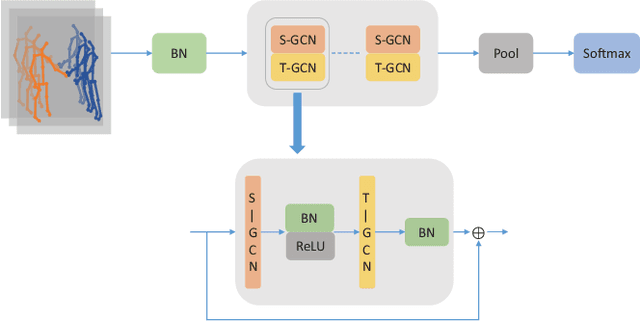
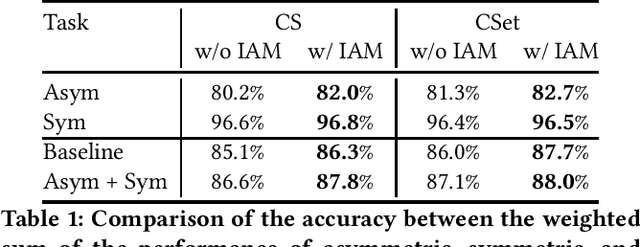

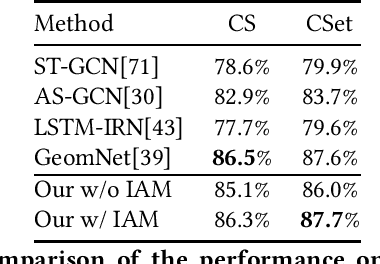
Abstract:How can we teach a computer to recognize 10,000 different actions? Deep learning has evolved from supervised and unsupervised to self-supervised approaches. In this paper, we present a new contrastive learning-based framework for decision tree-based classification of actions, including human-human interactions (HHI) and human-object interactions (HOI). The key idea is to translate the original multi-class action recognition into a series of binary classification tasks on a pre-constructed decision tree. Under the new framework of contrastive learning, we present the design of an interaction adjacent matrix (IAM) with skeleton graphs as the backbone for modeling various action-related attributes such as periodicity and symmetry. Through the construction of various pretext tasks, we obtain a series of binary classification nodes on the decision tree that can be combined to support higher-level recognition tasks. Experimental justification for the potential of our approach in real-world applications ranges from interaction recognition to symmetry detection. In particular, we have demonstrated the promising performance of video-based autism spectrum disorder (ASD) diagnosis on the CalTech interview video database.
A Saliency-Guided Street View Image Inpainting Framework for Efficient Last-Meters Wayfinding
May 14, 2022



Abstract:Global Positioning Systems (GPS) have played a crucial role in various navigation applications. Nevertheless, localizing the perfect destination within the last few meters remains an important but unresolved problem. Limited by the GPS positioning accuracy, navigation systems always show users a vicinity of a destination, but not its exact location. Street view images (SVI) in maps as an immersive media technology have served as an aid to provide the physical environment for human last-meters wayfinding. However, due to the large diversity of geographic context and acquisition conditions, the captured SVI always contains various distracting objects (e.g., pedestrians and vehicles), which will distract human visual attention from efficiently finding the destination in the last few meters. To address this problem, we highlight the importance of reducing visual distraction in image-based wayfinding by proposing a saliency-guided image inpainting framework. It aims at redirecting human visual attention from distracting objects to destination-related objects for more efficient and accurate wayfinding in the last meters. Specifically, a context-aware distracting object detection method driven by deep salient object detection has been designed to extract distracting objects from three semantic levels in SVI. Then we employ a large-mask inpainting method with fast Fourier convolutions to remove the detected distracting objects. Experimental results with both qualitative and quantitative analysis show that our saliency-guided inpainting method can not only achieve great perceptual quality in street view images but also redirect the human's visual attention to focus more on static location-related objects than distracting ones. The human-based evaluation also justified the effectiveness of our method in improving the efficiency of locating the target destination.
 Add to Chrome
Add to Chrome Add to Firefox
Add to Firefox Add to Edge
Add to Edge